
















































































all fibres








IBS symptoms so you can get back is the only unique, low-FODMAP fibre certified by Monash University to be effective in the treatment of an irritable colon (IBS) and proven to relieve symptoms such as constipation, diarrhea, gas, bloating,




and which (and let’s face it, embarrassing) gas.
FODMAP, 100% plant-based fibre


that provides gentle relief from to your regular schedule! and overall intestinal discomfort. inulin are high in FODMAPs, can cause bloating and painful (and completely in water: no grit, colour, or taste. associated with IBS





Dissolves quickly and mixes






Reduces abdominal discomfort




Gentle relief for constipation, diarrhea, gas, and bloating

Lead research University certified Fibre4 for IBS (irritable bowel syndrome)

There’s much more! Read the whole story at webbernaturals.com





















DECEMBER/JANUARY – 2025
CEO & Group Publisher • Ryan Benn
Group Vice President, Publishing & Operations • Nina Wagner
Group Content Director, Editor-in-Chief • Tracy Peternell
Managing Editor • Melissa Curman
Managing Editor, Custom & Special Projects • Alex Sarra-Davis
Senior Editor • Sandi Gauvin
Editor, CNHR • Bruce W. Cole
Editors • Laura Newton, Makena Wardle, Vibha Shukla
Managing Editor, Digital • Colleen Bryon
Social Media Coordinator • Michelle von Hahn
Group Creative Director & Photographer • Scott Yavis
Art Director, Publications • Iva Zima
Senior Graphic Designer • Alvarro Pastorin
Guest Senior Graphic Designer • Alithea Doyle-Cessna
Group Director of Operations • Devin Steinberg
Production Associate • Natasha Jayawardena
Vice President, Sales • Ellen Wheeler
Sales Coordinatior • Phileasha Gentry
Retail Account Executive, USA • Rebecca Randolph
Retail Account Executive, Canada • Aaron Alvarez
Group Vice President, Education & Administration • Jane Griffiths
Manager, HR & Administration • Ava Pashmchi
Executive Assistant • Hannah Dewar
Office Administrator • Celine Simpson
Manager, alive Academy • Julia Wagner Manager, Academy Admissions • Jan Clay
Director of Finance • Conroy Ing, CPA, CMA Senior Accountant • Maira Guzman
CONTACT INFORMATION
Alive Publishing Group Inc. 100-12751 Vulcan Way, Richmond, BC V6V
800.663.6580 Cover price is $5.75. Nine issues published per year. Canada Publications Mail Sales Product Agreement No. 40011604
ADVERTISING POLICY
sage accepts advertising based upon space availability and consistency with its mission to promote a natural health and wellness lifestyle. sage is not responsible for the content of advertisements, the products offered or the viewpoints expressed therein.
EDITORIAL NOTE
The information provided in this magazine is for educational and informational purposes only. It should not be used as a substitute for the advice of a qualified and licensed practitioner or health care provider. The opinions expressed here are not necessarily those of Alive Publishing Group Inc., its affiliates or parent company. Different views may appear in future articles or publications. Articles in sage are copyrighted and must not be reprinted, duplicated or transmitted without permission.

“Once your recipes are prepared and stashed safely away, all that’s needed is to plump up your pillows in front of the fire...”
P. 33
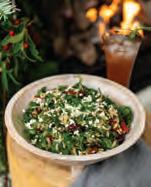
Shutterstock 6-11, 12-31, 50-51, 64, 66
Scott Yavis cover, 9, 32-49, 53-58
With the participation of the Government of Canada.






















































































































WELCOME
As 2024 draws to a close and we find ourselves on the precipice of a new year, it’s important to pause and reflect on what truly matters. In this issue of sage, we invite you to prioritize your health and wellbeing, to savour each moment, and to celebrate the beauty of this special time of year.
As we prepare for winter festivities, it can be easy to neglect our health. So, in this issue, we explore the science behind stress and offer strategies for managing it effectively. Then, we examine the importance of daily movement, and how much exercise can do for our bodies and minds.
Next, in preparation for the new year, we invite you to step beyond short-lived resolutions and set goals that will result in meaningful change. As we think about changes we can make for our overall health and wellness, we also take a close look at macros and micros, examining the full-body benefits of whole foods, and how to approach healthy eating without the need for fad dieting.
To bring warmth to your winter, we’ve included mouth-watering recipes for one-pot soups, salads, and stews, perfect for gathering friends and loved ones around the table. Plus, we’ve also got recipes for those cozy nights by the fire, and delectable dishes inspired by winter-white foods!
Whatever your winter season brings, we’re wishing you continued health and wellness—and a joyful year ahead!
The team at sage




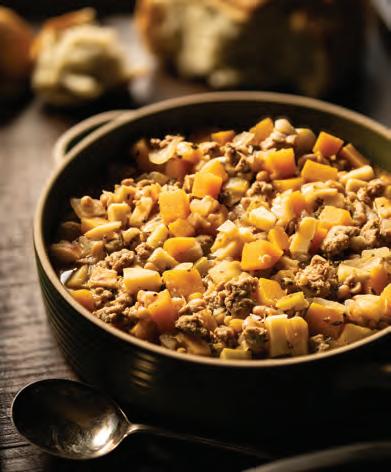


Relieve stress and anxiety while getting your heart rate up with shadow boxing, a high-intensity exercise program that can be modified for any fitness level.
Native to tropical climates in South Asia and Africa, tamarind (Tamarindus indica) is a type of fruit that comes from the tamarind tree. Known for its intensely sour flavor and sticky texture, under-ripe tamarind needs to be cooked or pickled before it can be eaten. Ripe tamarind pulp, which comes in solid blocks or as a paste, can be added directly to recipes.
As a savory ingredient, tamarind is used as a meat tenderizer, in curry dishes, and—most famously for North Americans—in pad Thai sauce. Also prized for its sour flavor in sweet recipes, it can be found in candy, chutney, and in the form of spicy-sweet straws for Mexican mangonadas.
In some medical studies, tamarind has shown promise for its positive effect on dry eye, peptic ulcers, and inflammation. In traditional medicine, the soft bark and roots of the tamarind tree are used to treat constipation.
Unlike heavy bag boxing, which requires a punching bag and boxing gloves, shadow boxing can be done at home or at the gym—it can even be done sitting in a chair.
Shadow boxing typically consists of punching and footwork drills, jump training, and bodyweight strengthening exercises such as push-ups and planks. Like traditional boxing, shadow boxing may produce a variety of health benefits, including improved strength, endurance, and heart health.
This sport and exercise method also has a positive effect on emotional health. In one study, non-contact boxing showed promise as an intervention tool for those suffering from the effects of mental illness.


Menstrual cups and discs are enjoying a well-deserved moment in the spotlight thanks to a recent study published by UC Berkely. The study revealed that tampons can contain toxic chemicals such as lead, cadmium, and arsenic. Of particular concern is the fact that the vaginal wall is able to absorb these chemicals more efficiently than other parts of the body.
Enter the menstrual cup—or its younger sister, the menstrual disc. Now available in a wide variety of sizes and shapes, this innovative product is a small, flexible cup made of soft material such as silicone, natural rubber, or latex. The cup or disc is inserted into the vagina to collect menstrual flow and then removed, emptied, and rinsed so it can be used again.
The benefits of using a menstrual cup or disc are numerous: they can be left in for up to 12 hours, you can wear one before your period starts, they’re more eco-friendly than disposable products, and they can hold more liquid than a tampon.

Spa water has officially been given a social media makeover by TikTok creator Kelly Stranwick, who refers to her super-hydrating concoction as “sexy water.” An updated riff on the infused water trend, sexy water (or glow water) hydrates with the help of fruit, herbs, and supplements.
Fans of this trend add ingredients like sprigs of spearmint, citrus slices, colostrum, and powdered adaptogenic mushrooms to glasses of water. To make increased hydration appealing to all the senses, some also add extra ice, a metal drinking straw, and a pretty bottle or cup.
Although research shows that water infused with herbs and fruit may not retain enough nutrients to have any real health benefits, it does add a nice flavor to the water. Adding some sparkle to the process can help motivate you to reach your daily water drinking goal of two to three liters, which will benefit your health!
“Higher level of aerobic exercise can reduce the risk of breast, colon, bladder, endometrial, and digestive tract cancers.”



As children, we crave movement, but our grown-up selves often choose to forgo exercise. We’re stressed and tired, and exercise adds to that. Or does it? While a physical stress inducer, exercise helps our ability to deal with stress in general and makes us healthier, too.

A walk around the neighbourhood will lift your mood and improve your health. It’s not magic. It’s what movement does. Blood delivers more oxygen to our muscles, which in turn helps them process “fuel” more efficiently.
Brain health
Regular exercise, because it delivers more oxygen to our brain, helps improve brain health, delay brain aging, and reduce the risk of neurodegenerative diseases such as dementia and Parkinson’s.
Weight management
While diet helps address weight issues, exercise helps with weight management and reduces the risk of developing metabolic syndrome, insulin resistance and type 2 diabetes, cancer, and cardiovascular disease.
Sleep and sex
We sleep better with exercise, have a better sex life, and improve self-esteem, too.
“Exercise can help the body develop a robust response to stress and dial down the risk of depression.”
As for exercise being stressful … it does increase cortisol levels, but unlike psychological stress, exercise-induced cortisol is soon inactivated, a desirable outcome that makes our bodies more resilient to stress.
As we age, certain exercises, such as standing on one leg, can help increase stability, which is essential for reducing the risk of falls and injury.
We’ve all heard it said repeatedly that moving after a meal has many benefits.
Active muscles are a great “sink” for glucose, helping the body’s response to the post-meal sugar influx. In the long run, daily exercise (ideally aerobic and resistance) can improve insulin sensitivity and reduce the risk of developing type 2 diabetes and metabolic syndrome.
Our gut bugs also benefit from exercise. Active people tend to have more beneficial bacteria, some of which produce butyrate, a short-chain fatty acid with anti-inflammatory and gut lining repair properties, while others contribute to improved metabolic health. Regular exercise has positive impacts on dysbiosis as well as symptoms of irritable bowel syndrome.
Feeling blue? Go for a walk, jog, or hike. Aside from reducing stress and increasing oxygenated blood flow to the brain, aerobic exercise generates complex molecules called endocannabinoids that can suppress pain and enhance well-being (the so-called runner’s high) and have positive impacts on brain health, cardiovascular health, gut motility, and insulin sensitivity.
Speaking of desirable highs, did you know that serotonin levels, known as “the happiness molecule,” increase when we exercise? Among others, this helps us manage emotions better (translation: step away from a conflict and go for a walk; you’ll find better words upon returning).
Nitric oxide, which also increases with exercise, can have an analgesic effect and helps improve cardiovascular health by reducing blood pressure, often a consequence of acute and chronic stress. Exercise can help the body develop a robust response to stress, dial down the risk of depression, and lower inflammation levels and oxidative stress in the brain.
Regular exercise can significantly reduce the risk of developing neurodegenerative diseases; it boosts cognition, memory, and the ability to learn by helping growth of new neurons.
Up to 40 percent of cancers can be prevented by changing our lifestyle, and exercise is a critical lifestyle choice.
Higher levels of aerobic exercise can reduce the risk of breast, colon, bladder, endometrial, and digestive tract cancers, and picking up some weights may also work in our favour by slashing the risk of kidney and bladder cancer while also impacting total cancer mortality.
This is due in part to myokines, which are produced in the muscles during exercise and can inhibit cancer growth. And here’s the best incentive of all: myokines are only secreted during exercise, both aerobic and anaerobic, and help prevent and attenuate agingrelated conditions such as sarcopenia, dementia, obesity, and cardiovascular and metabolic diseases.
No matter where you are today, think about daily movement as your most reliable ally in improving health, mood, and the chance of aging gracefully. Every step counts (and so does dancing!), so why not start today?

Make it a daily affair
Make a goal
Work toward a goal of two to four workout days (bodyweight, light weights, heavier weights, wherever you’re at), each session at least 20 minutes.
Take a walk
Get a brisk walk in (with a checkmark on the calendar for accountability!) at least 30 minutes a day, five days a week. If 10 minutes is all you have, go for it!
Include NEPA NEPA stands for non-exercise physical activity. It’s exactly what it says: movement as it happens. All of it counts for health and well-being. NEPA can include the following: taking the stairs replacing sitting with standing when possible walking instead of driving getting up from sitting and walking around stretching tidying up gardening playing with your kids and/or dog

MAINTAINING HEALTH THROUGH THE HOLIDAYS
ROLFE, BA, DIPA

The holidays are filled with family, friends, food, drinks, music, more food, parties, and—you guessed it—even more food! It can be a busy time with commitments that may add joy to your life, but also stress to your schedule and your body. While you may have been able to prioritize fitness, physical activities, and conscientious eating for much of the year, the holidays can be jarring to healthy habits.
Here are the keys to maintaining health through the holidays without impeding your enjoyment.
Sleep may be the most overlooked and underrated component of health. In fact, research has shown a significant link between sleep deprivation (sleeping less than seven hours per night) and a wide range of physical health issues, such as hypertension, diabetes, cardiovascular diseases, and impaired immune function.
TIP : Prioritize sleep (and naps) where and when you can!
A major challenge many of us face over the holidays involves meal, snack, and dessert choices. Chocolates, treats, and adult beverages are holiday staples. They’re in your face (and often end up in your mouth). Here are a few real-world strategies that will help keep you on track.
It’s like your pre-nightclub college days, but the exact opposite, for the times when you know you’re going to a party, gathering, or dinner where there’ll be bonbons galore.
TIP: Eat nutritious foods that are high in protein and fibre (both of which are known to keep you fuller longer) right before you go.
This is probably filed under the “duh” category of Captain Obvious’ tips, but it’s not what you think. The advice is not to “eat less,” but rather to normalize smaller portion sizes, because research illustrates that normalizing smaller portion sizes now has a mitigating effect on future portion size choices.
TIP: Keep it small; it’s perfectly fine to go back for a second small helping if you want.

Before you conveniently misconstrue, let’s be clear: stay hydrated with water Research shows a correlation between increased hydration levels and both greater feelings of fullness and lower trends toward choosing salty foods.
TIP : Remember to get enough water; drinking alcohol can actually dehydrate.
You can usually plan movement and nutritious eating around holiday parties and family gatherings.
You might not be able to predict your co-worker bringing treats to the office, or when your kids threaten a hunger strike unless they get a full pancake breakfast. You can plan for this happening more often during the holiday season.
TIP: The “80/20 rule” suggests that if you eat in a mindful, intentional, and healthy manner (nutritious foods and appropriate portion sizes) 80 percent of the time, your body can deal with the other 20 percent without lasting impact to your health. Studies suggest this may also have positive psychological benefits, since it strategizes for inevitable deviation from healthy eating.
In that same spirit, be prepared to move your body when the opportunity arises. No, it may not be your step class, a spin session, or your regular gym workout, but any physical activity is better than none.
TIP : A 15-minute jog between meetings, a 10-minute stretch while your toddler is napping, or an after-dinner walk can keep you moving and make it easier to get back into your regular routine once your schedule normalizes.
Stephanie Rolfe, a health coach who specializes in behaviour change, believes that even goals set with the best intentions may fail without “gravity.”
“The key to setting any goal that will lead to long-lasting change,” says Rolfe, “is choosing those that have meaning. They have gravity! They’re grounded in your values and answer the question of ‘why?’
“Losing 10 pounds sounds nice, but as a goal it does little to light a fire ... Wanting to lose 10 pounds so you can move with less effort, feel energized, and keep up with your kids for years to come—that’s something worth working for.”
Once you’ve figured out your why, Rolfe suggests getting specific with your how: “… what you’re going to do, when, how often, and with whom are details that can help you get clear on your plan and make taking action easier and less overwhelming.
“Be realistic, though. If you’re not 9/10 (or more) confident that you can meet those action goals, break it down into smaller pieces and try again. The little actions add up!”
Planning for the holidays may also mean planning for nutritional gaps. Here are some of the supplements you may want to consider prioritizing in your plan.
vitamin insurance policy
powders support overall wellness when veggie intake is low

“Research illustrates that normalizing smaller portion sizes now has a mitigating effect on future portion size choices.”

“The physiological stress response is triggered when we perceive there is a threat to our survival, safety, status, or well-being.”

We tend to think of stress as a bad thing, and that’s certainly fair considering how many chronic diseases and mental health issues are stress related. But we often fail to distinguish between sources of stress and the body’s response to those stressors. In doing so, we downplay our ability to change how we perceive life’s slings and arrows, thereby mitigating the effect of stress on our well-being.
Understanding the body’s response to stressors and learning techniques to cope with stress are paramount for cultivating health now and minimizing the risk of stress-related disease in the years to come.
The physiological stress response is triggered when we perceive there is a threat to our survival, safety, status, or well-being. The stress response, commonly referred to as the “fight or flight” response, is mediated by the sympathetic nervous system.
Coming face-to-face with a lion, tiger, or bear triggers the adrenal glands to release neurotransmitters such as adrenalin and noradrenalin, as well as the hormone cortisol. Cortisol has an anti-inflammatory effect in the body and mobilizes stored glucose for energy.
These chemical changes cause an increase in heart rate, respiration, alertness, and muscular strength to promote survival.
For most suburban Canadians, however, our stressors tend to look less like wild animals and more like rising inflation, work deadlines, and family responsibilities. While many of these stressors don’t pose a threat to our immediate survival, the body perceives them as a danger nonetheless, and launches the stress response to help us cope and perform.
For instance, getting butterflies in your stomach before giving a work presentation is a sign that the stress response is engaged to enhance performance.
Cognitive health
Chronic stress can promote atrophy of the brain and negatively affect processing and cognition.
Mood disorders
Stress is associated with mood disorders such as depression.
Immune function
Stress can impair immune activity and promote the growth of malignant tumours.
Gastrointestinal health
Stress promotes inflammation in the gut and triggers intestinal hyperpermeability (leaky gut).
Hormone health
Stress can alter the normal functioning of the thyroid, pancreas, hypothalamus, pituitary, and adrenal glands.

Acute psychological stress may manifest as headache, insomnia, upset stomach, muscle tension, and/or irritability, although everyone’s experience of stress is different.
“If stressors continue, we ‘adapt’ to our stress,” explains Katie Thomson Aitken, naturopath and author of Create Calm . Once stress becomes chronic, the initial feelings of alertness and panic fade, although this isn’t necessarily a good sign.
“This may feel better in the short term, but over time, it can create feelings of fatigue and contribute to other health challenges if not addressed,” Thomson Aitken adds. If left untreated, chronic stress can also lead to burnout.
Among some people, acute stress can trigger post-traumatic stress disorder (PTSD). “How our brain stores the stressful experience can change how we experience the stress moving forward,” says Thomson Aitken. “In PTSD, the stressful event being remembered is experienced in the body as if it is happening in the present: a re-creation of the stress response rather than a chronic one.”
Helpful coping strategies include the confrontation of stressors as well as cognitive reappraisal.
Acknowledging where you may be taking on unnecessary stressors may be helpful.
“Many people with anxiety tend toward perfectionist thinking,” says Thomson Aitken. This might present as feeling the need to maintain a spotless home at the expense of getting enough sleep, for instance. “This is the type of stressor that can be changed by internal work to challenge and reframe perfectionism.”
When confronted by a stressor that feels massive, Thomson Aitken recommends reframing the problem by identifying what is within our control and what is not. “This type of thinking moves us from despair to hope,” says Thomson Aitken, “and can make a huge difference in how we experience a stressor.”
Unhealthy responses to stressors include magnification (catastrophization), rumination, and helplessness. These

responses can intensify cortisol release and condition the body to become more sensitized to future stressors.
An exaggerated response to stress contributes to cortisol dysfunction, inflammation, and increased pain, opening the door to stress-related health conditions.
Many people are aware of the benefits of meditation, deep breathing, and yoga for stress management. But oftentimes these practices are overwhelming for those who are new to them and are already feeling stressed.
In this case, Thomson Aitken recommends getting back to basics by considering the foundations of health. Invest in your bedtime routine, nutrition habits, exercise regimen, mindfulness practice, and social connections. If that still feels like too much, choose one and watch what changes!
You may benefit from outsourcing your stress management so that you can feel taken care of. Consider acupuncture or massage therapy to reduce stress and promote relaxation.
SUPPLEMENT BENEFIT FOR STRESS
ashwagandha has antistress and antianxiety properties, which may alleviate insomnia and depression
L-theanine may improve stress-related symptoms
magnesium may help improve subjective sense of anxiety and may help treat depression
rhodiola influences the release of stress hormones and may improve stressinduced conditions
lemon balm may decrease stress, anxiety, and depression
valerian has antianxiety properties
vitamin B complex supplementation may benefit stress
vitamin D and omega-3
co-supplementation may improve depression, anxiety, and sleep quality among women with low vitamin D and prediabetes
probiotics may improve mental function among those with anxiety and depression
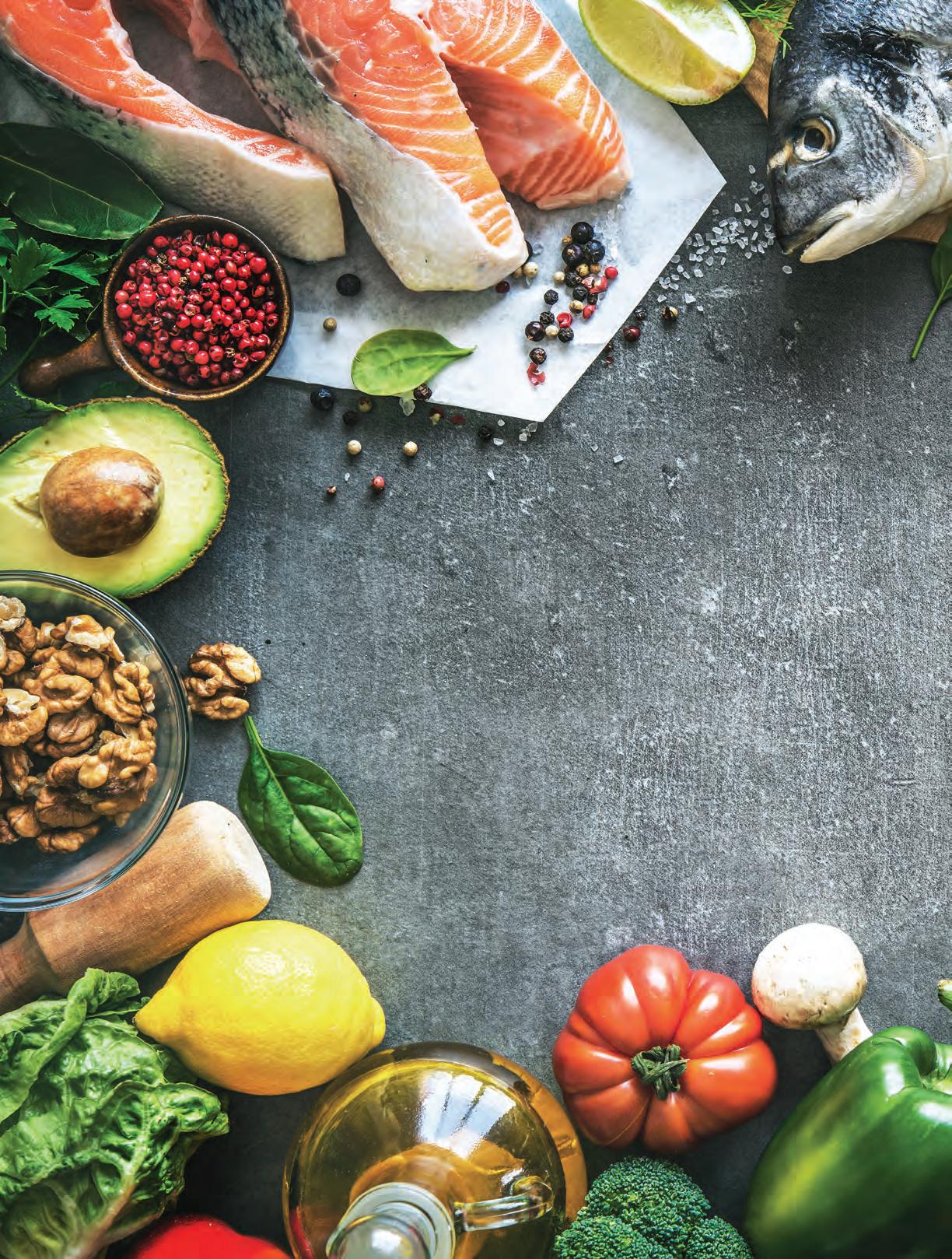
UNDERSTANDING THE ROLE .. MACROS OF MICROS ..
BRITTANY DEVENYI

FAT, PROTEIN, AND CARBS
the big three macronutrients have all had their turn being vilified throughout diet culture. From problematic phrases such as “all fats are unhealthy” and “watch your carbs” to misguided rhetoric about protein being the only way to build muscle, these macronutrients have been given a false narrative. This powerful triad of nutrients, in tandem with essential vitamins and minerals, is what our body relies on to thrive.
As we usher in a new year, it’s important to step back and better understand the integral role these nutrients play in our everyday lives, while working to break down some of the common misconceptions they often carry with them.
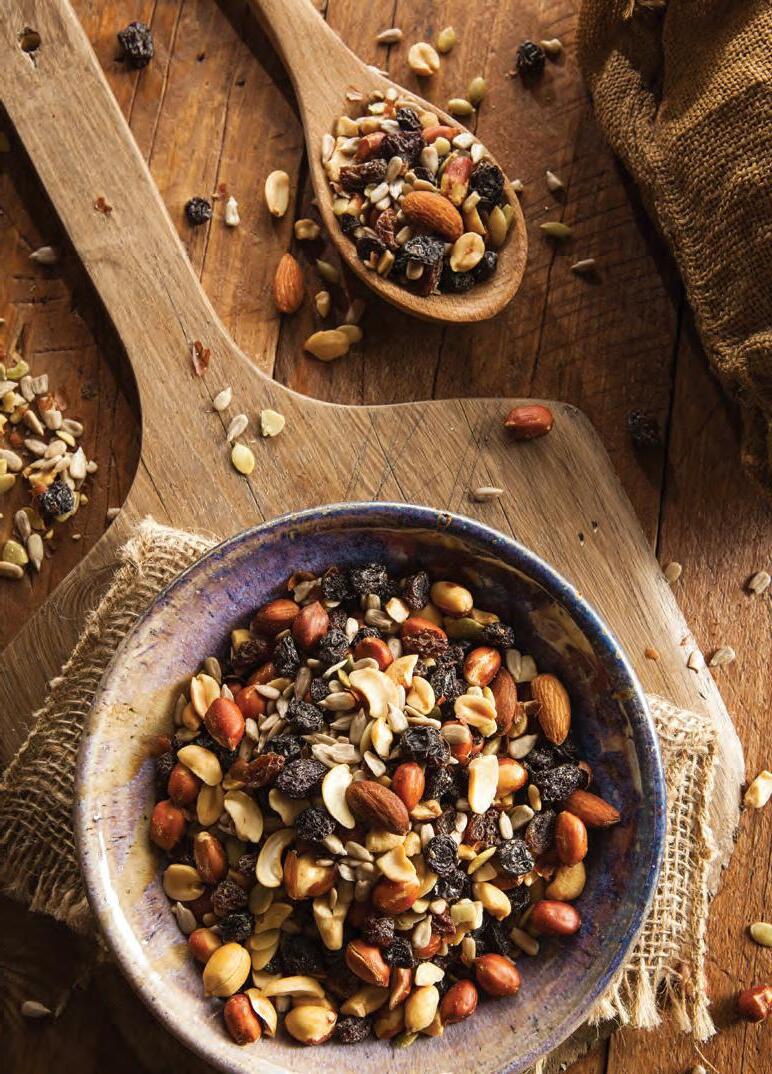
The ABCs of macros and micros
So, what exactly are these all-important nutrients?
In simple terms, macronutrients refer to the nutrients our body relies on for energy, which we require in large amounts (hence the term macro) to make up our total caloric intake. The big three macros: protein, carbohydrates, and fat.
“All three macronutrients are considered essential, which means we have to consume them in the diet for good health and function,” says Brooke Bulloch, a Saskatoon-based registered dietitian. “It’s really to sustain life and longevity.”
On the other hand, micronutrients are the nutrients our body requires in trace amounts. These come in the form of vitamins and minerals. And while they don’t affect our diet from a caloric standpoint, they’re still essential for our health and well-being—from B-complex vitamins’ role in energy production and digestion to iron’s impact on cognitive function and immune support.
While protein, carbohydrates, and fat are widely known nutrients, there’s plenty of mixed messaging around them, such as the “correct” daily protein requirement and the “healthiest” form of carbs. Here, we dig into the fundamentals of each and explain why it’s the balance of all three macros that deserves our true attention.
This powerhouse nutrient is something of a workhorse. Made up of amino acids (the “building blocks” of protein), it helps build and repair our muscles, bones, skin, and other tissues. It also plays a role in hormone and enzyme production.
While a complete protein contains all nine essential amino acids that our body can’t produce on its own, Bulloch says there’s too much fixation on consuming complete proteins each day, when really, the focus should be on nutritional variety.
“Even with a plant-based diet, when we’re consuming ‘incomplete’ proteins, you don’t have to complete your proteins at every single meal or every single day,” she explains. “By eating a variety of foods, you’re adding to your amino acid pool and the body will draw from that pool as needed.”
In fact, studies confirm that most people in North America consume more than enough protein. What carries more nutritional impact is the “protein package.” In other words, the quality of that food source and the essential nutrients contained within it.
Most people require between 25 and 38 g of fibre per day, but most Canadians are only consuming about half the necessary amount. A few fibre-rich foods that Leigh Merotto, RD, recommends including in our diet rotation include whole grains such as quinoa and wild rice, fruits, vegetables such as broccoli and sweet potato, pulses and legumes, nuts, and seeds.
Fibre supplements, such as psyllium and inulin, can also lend support at times when getting enough fibre through diet alone is difficult.
Despite a once-shaky reputation, fat (especially the heart-healthy unsaturated variety) is integral to a healthy, balanced diet. One of its main superpowers: helping the body absorb fat-soluble vitamins A, D, E, and K. “In order to absorb these nutrients properly, we need fat,” says Bulloch. Fat also protects our organs, aids in cell growth, promotes better cognitive function, and provides us with sustained energy.
This long-feared nutrient is too often distilled down to mean bread and pasta. “We need carbohydrates because they are our brain and body’s primary source of fuel and energy,” explains Leigh Merotto, a Toronto-based registered dietitian who specializes in gut health.
Carbs are broken down into simple sugars (called monosaccharides) that enter the bloodstream and are used by all cells in the body for energy. When we’re consuming carbs in their whole food form (think fruits, vegetables, whole grains, and legumes), they also provide us with fibre and prebiotics, which are necessary for efficient digestion.
“We need fibre to keep our digestive tract healthy,” explains Merotto. “It feeds our good gut bacteria and produces things called short-chain fatty acids, which help to mediate and regulate inflammation in the gut and keep our intestinal barrier healthy.” Plus, fibre keeps our bowel movements regular (one of our body’s three forms of detoxification).
While no nutrient alone holds the key to overall well-being, the secret is to consume a balance of macros and micros in their minimally processed form. Bulloch also explains how the diet messaging around “cutting” is unhelpful and unsustainable. A better alternative: asking ourselves what we can add to our plates.
“‘What can we add to the diet?’ is a really great question because it’s a little bit more neutral,” says Bulloch. “It removes some of the moralization we often see around food.”
Ultimately, she says, our diets should be filled with foods that bring us joy—whether it’s a veggie-packed stir-fry or our favourite homemade dessert. That, as it turns out, is the closest thing to a winning recipe.
You may be familiar with the term “tracking macros” (calculating how many grams of each macronutrient you consume each day), but according to Brooke Bulloch, RD, this can lead people down a precarious path of food obsession and body dissatisfaction.
“It can also teach a person to ignore their hunger and fullness cues,” she says. Instead, focus on a well-rounded whole food diet packed with essential micronutrients.
iron
meat, seafood, legumes, spinach, tofu (pair plant-based sources with vitamin C for better absorption)
zinc shellfish, poultry, legumes, pine nuts, cashews, whole grains
calcium milk, yogurt, winter squash, edamame, almonds, leafy greens
magnesium almonds, pumpkin seeds, beans, brown rice, bananas
vitamin A leafy greens, carrots, sweet potatoes, cantaloupe, tomato
vitamin D fatty fish, sardines, eggs, wild mushrooms
vitamin B12 clams, salmon, tuna, yogurt, eggs, (fortified) nutritional yeast

BRENDAN ROLFE, BA, DIPA
Ihave three daughters under the age of five; naturally, unicorns are a big part of my life. They also serve as a reminder that true brilliance is rare (outside of Equestria) and that striving to be a unicorn, when the human need to belong and assimilate is deeply ingrained, takes mental presence and physical intent.

“Think about the desires and goals you’ve set for yourself. Are they genuinely aligned with your values and dreams?”
Self-doubt may sneak in from time to time, but you can counter it with positive affirmations, meditation, or seeking support.
Unicorn versus chameleon
The first step in self-actualization (achieving a fundamental life balance that leads you to strive for growth and change) is to differentiate between perceived external expectations and the changes, growth, and milestones that are genuinely meaningful to you. It’s like distinguishing between a chameleon and a unicorn—one blends in, while the other stands out proudly.
Think about the desires and goals you’ve set for yourself. Are they genuinely aligned with your values and dreams, or are they a product of societal pressures and expectations? For those struggling to find balance, Thais Aratangy, of the Canadian Mental Health Association, suggests “spending more time with yourself.”
“The more you know you, the more you come to understand your true likes and values, which will help determine what is important to you,” says Aratangy. “This then empowers you to set and maintain boundaries regarding the priorities in your life.”
Who is your best self? What does that look like? Three pillars set the foundation for everything else in your life: sleep, movement, and food.
SLEEP: Sleep is the magic potion that revitalizes our bodies and minds. Studies have determined that anything less than seven hours per night is considered “deprivation,” and you’re mentally and physically worse for wear if you come up shy. Create a bedtime routine that helps you gradually wind down so you get a quality sleep.
MOVEMENT: Unicorns are known for their graceful and spirited gallops. While you don’t have to break into a gallop (unless you want to—no judgment here), regular physical activity is vital. Find a form of movement that brings you joy, whether it’s dancing like nobody’s watching or yoga with other sweaty unicorns (again, no judgment).

There isn’t just one way to reflect; the “how” is up to you. Any activity that allows you to focus on a thought and consider its different elements counts as reflection. It may be something as formal as journalling or list writing; something techy, such as feelingtracking apps; something physical, such as meditating; or something as simple and informal as tea with a friend.
The point is for you to take a dedicated moment to consider, assess, note, and name your experiences that day and reconcile how they fit (or not) into your current goals, desires, and life plans.
FOOD: Nourish yourself with wholesome foods that make you feel vibrant and alive. Remember, your inner unicorn thrives on colourful and nutritious meals (save beige for your cargo pants collection).
SUPPLEMENTS: Sometimes, even unicorns need a little extra sparkle. Consult a healthcare professional to determine if supplements can help you meet your specific needs. But remember, they’re like the glitter on a unicorn’s horn—they enhance, not replace, your foundation.

A positive mindset and diamond-solid self-belief turn obstacles into opportunities. They don’t make you blind to the fact that the world isn’t rainbows. They do give you the ability to see beyond the problem at hand, not only to find creative solutions but also to understand that things can always be much worse (file this under gratitude).
Start by affirming your worthiness on a daily basis. This will help you believe in yourself like you’re the last unicorn on earth. Self-doubt may sneak in from time to time, but you can counter it with positive affirmations, meditation, or seeking support from a mental health professional.
Behaviour patterns: Notice and name
As you continue your quest to become the best versions of yourself, be mindful of habits and behaviours that hinder your progress. Identify the triggers that lead you down a path of procrastination or self-sabotage.
Do you watch TV while eating a meal (mindless eating) or scroll through your phone instead of starting your day with purpose? When you spot patterns, write them down and replace them with habits that align with your goals.
Rather than focusing on “cutting out” negatives (such as eating less fast food), add positives (eating a fruit or vegetable with every meal). Eventually, positive behaviours start to crowd out less desirable ones, and they naturally and less painfully fall by the wayside. Small positive changes, made on a regular basis, can have a significant positive cumulative effect.
We’ve all had moments when we’ve felt like we stumbled and fallen on our quest for self-improvement. What differentiates a unicorn from the rest of the herd is the ability to get up and push forward. It’s time to let go of past “failures” or perceived shortcomings.
Instead of dwelling on the past, use it as a stepping stone toward a brighter future. Each experience, no matter how challenging, has shaped you into the person you are today. Embrace your imperfections and let them be an important part of your journey.
The most important takeaway from every My Little Pony movie ever made: good friends are important. The importance of a strong support network can’t be overstated. In fact, it’s one of the most important factors, if not the most important, in achieving your goals and maintaining positive change.
Registered psychologist Bea Mackay, PhD, strongly believes that “friends and families who have healthy ways to dissipate the natural tension that builds from friendships and living together, such as playing sports, games, singing, and being creative, do better in life than those who don’t.”
Surround yourself with those who make you a better person. “Accepting that you can’t do everything on your own,” adds Aratangy, “will allow you to stride further.”

RECIPES TO WARM YOUR SOUL
RECIPES IRENE MCGUINNESS | FOOD STYLING BRUCE NOLLERT | PHOTOS SCOTT YAVIS
We all know how harried we can become during the holiday season, and settling into cozy cushions in front of a fireplace is where many of our hearts long to be. If you’re trying to hunker down and create some order in the next month, these dishes will help.
Unexpected company? A feta dip whipped up in a blender is an easy fix alongside a dish of crackers and chopped veggies. And who doesn’t love soup? Making soup ahead and freezing it makes a super-easy answer for unexpected dinner guests. Just thaw it out and dress it up into a meal your guests will love.
It’s all in the planning. These recipes (and their mocktail accompaniments) come to you ahead of the season so you can be sure to get your party plans in order—and ready to just pull out, heat, and serve. Once your recipes are prepared and stashed safely away, all that’s needed is to plump up your pillows in front of the fire and answer the phone: “Sure! Come on over, I have a delicious curry warming up.”

Fireside nibbles—one simply can’t get enough of them. This eye-catching dip is so easy to prepare: just whip it up in a blender and serve with your choice of veggies or bread crisps for scooping. It’s equally delicious spread on crostini and topped with bruschetta.
MAKES 2 1/4 CUPS (560 ML)
Zesty sparkler mocktail
Serve your delicious Creamy Feta Dip with this zesty sparkling mocktail and you’ll have folks lining up for more. For an extra flavour boost, add a little fresh tarragon.
3 or 4 cucumber slices
2 Tbsp (30 mL) honey syrup
1 Tbsp (15 mL) freshly squeezed lime juice
Sparkling soda
Fresh tarragon (optional)
Using wooden spoon in deep bowl, muddle cucumber slices with honey syrup and lime juice. In highball glass, place a couple of ice cubes and strain cucumber juice overtop. Add sparkling soda and garnish, as desired. For extra flavour, muddle in fresh tarragon with your cucumber.
1 1/4 cups (310 mL) 2% cottage cheese
3/4 cup (180 mL) coarsely crumbled feta cheese
1/2 cup (125 mL) plain yogurt
1 small garlic clove, peeled, smashed, and minced
1 tsp (5 mL) lemon zest
2 Tbsp (30 mL) extra-virgin olive oil
1 Tbsp (15 mL) freshly squeezed lemon juice
1 1/2 Tbsp (22 mL) quid honey
Generous pinch of crushed red pepper flakes
Toppings: extra-virgin olive oil, chopped fresh mint or parsley, toasted chopped pistachios, or pomegranate seeds (optional)
1. In high-speed blender, combine all ingredients except honey, crushed red pepper flakes, and toppings. Whirl until dip is creamy and smooth, scraping down sides of bowl as you go. Using spatula, spread out in shallow bowl, creating swirls.
2. Drizzle with honey and scatter with crushed red pepper flakes followed by toppings of choice. Serve with crusty bread, crisp vegetables, or pita chips for dipping.
“THIS EYE-CATCHING DIP IS SO EASY TO PREPARE AND IS EQUALLY DELICIOUS SPREAD ON CROSTINI
AND TOPPED WITH BRUSCHETTA.”
Dip can also be served warm. Transfer dip without toppings to small baking dish that is microwave or oven safe. Heat in microwave until bubbly, or bake uncovered in 400 F (200 C) oven until bubbly and golden on top. Garnish with toppings and serve.
Cozy comfort in a bowl—this dish with charred vegetables offers flavours from Tunisia and other regions in the Middle East. And who wouldn’t want a bowl of Middle Eastern spices to warm the tongue while satisfying the belly on a cold winter night?
SERVES 8
4 cups (1 L) grape tomatoes
1 cup (250 mL) peeled and diced sweet potato
1 large red bell pepper, cored and chopped
4 large garlic cloves, peeled
2 Tbsp (30 mL) extra-virgin olive oil, divided
1 yellow onion, peeled and diced
1 cup (250 mL)
diced carrot
1 cup (250 mL)
diced celery
2 Tbsp (30 mL) slivered sun-dried tomatoes in oil
1 Tbsp (15 mL) harissa seasoning or paste
6 cups (1.5 L) low-sodium vegetable stock
1 tsp (5 mL) apple cider vinegar or lemon juice
1/2 tsp (2 mL) maple syrup
Salt and pepper (optional)
Toppings: cilantro, mint, toasted croutons, creamy plain yogurt, barberries, or pomegranate arils (optional)
1. Preheat oven to 375 F (190 C). Line large baking sheet with parchment and set aside.
2. In large bowl, combine tomatoes, diced sweet potato, red pepper, and garlic. Drizzle with 1 Tbsp (15 mL) olive oil and toss to lightly coat. Spread out on baking sheet in an even layer. Roast in centre of oven for 35 to 40 minutes, or until vegetables are lightly charred.
3. In large, heavy saucepan over medium heat, add remaining olive oil, diced onion, carrot, and celery. Sauté, stirring often, until onions are soft and clear and carrots and celery are just turning slightly golden, about 15 minutes. Add a splash of water, if necessary, to keep vegetables from sticking. Add sun-dried tomatoes and harissa and stir in. Then add vegetable stock and bring to a gentle boil. Remove from heat and set aside while vegetables in oven finish roasting.
4. When oven-roasted vegetables are done as you like, transfer along with any of their precious juices to saucepan with vegetable stock mixture. Stir in, return to heat, and bring to a gentle boil to fully amalgamate flavours. Stir in vinegar and maple syrup. Using hand-held stick blender or highspeed blender, purée mixture until smooth and creamy. Add a splash more vinegar coupled with salt and pepper, to taste, if you wish.
5. Serve steaming hot in mugs or bowls with your choice of toppings. Soup can be refrigerated for up to 4 days or frozen for longer storage.
The perfect companion for our Middle Easterninspired comfort in a bowl, this mocktail is as easy as it is unique and delicious.
Cinnamon stick
1/2 cup (120 mL) water
Thyme sprigs
1 tsp (5 mL) agave syrup
1 tsp (5 mL) harissa seasoning
Sparkling water
1 tsp fresh lime juice
Small pinch of sea salt
In small, dry saucepan, shake cinnamon stick over medium heat until it begins to smell aromatic. Add water, generous sprigs of thyme, agave syrup, and harissa. Stir over medium heat until simmering and blended. Fill highball glass with ice cubes. Strain mixture overtop and fill glass with sparkling water; garnish as desired.
“ A BOWL RICH IN MIDDLE EASTERN SPICES TO WARM THE TONGUE WHILE SATISFYING THE BELLY ON A COLD WINTER NIGHT. ”

MAKE MINE A MEAL
Jazz up soup into a stew by puréeing it only a bit to keep it chunky. Stir in canned lentils and fold in some chopped spinach or kale for a festive seasonal colour. Round up the flavours with a smattering of coarsely chopped Marcona almonds, dollops of thick plain yogurt, and fresh mint.

Orzo is an excellent pasta to have on hand; it lends itself to so many variations. If you’re looking for another flavourful combo, toss orzo pasta with your favourite miso dressing and a medley of chopped sweet peppers, cucumber, and cilantro. Scatter with crumbled goats’ cheese and toasted pepitas. Mmmm.
This recipe is something of a classic; it’s so easy to make. But this version introduces a little extra zing for when the season revs up and all you want to do is curl up in front of the fire for a cozy eve. All it takes is one pot for cooking and a single bowl to toss with remaining ingredients. It doesn’t get much easier than that. The gremolata gives it that zesty, zingy punch.
6
Orzo pasta
1 cup (250 mL) uncooked orzo pasta
3 Tbsp (45 mL) extra-virgin olive oil
1 Tbsp (15 mL) freshly squeezed lemon juice
1/4 cup (60 mL) thinly shredded fresh basil
1 large garlic clove, peeled, smashed, and minced
2 whole green onions, thinly sliced
300 g pkg fresh baby spinach leaves, washed and spun dry
1/2 cup (125 mL) artichokes packed in oil, quartered
1 roasted red pepper, cut into strips
1/3 cup (80 mL)
pitted kalamata olives, halved
1/4 tsp (1 mL) sea salt
1/4 tsp (1 mL) freshly ground black pepper
1/4 cup (60 mL) crumbled feta cheese
Gremolata
1 small bunch Italian parsley, chopped
1 Tbsp (15 mL) orange zest
2 tsp (10 mL) lemon zest
1 large garlic clove, peeled, smashed, and minced
With tons of citrus hints in this dish and the pungent Greek flavours of olives, artichokes, and garlic, keeping it simple is the perfect choice. Fill a beer glass with ice cubes and top with equal parts unsweetened grapefruit juice, sparkling soda, and a splash of honey syrup. Garnish with a sprig of rosemary.
1. In large saucepan, bring 8 cups (2 L) water seasoned with salt to a full rolling boil. Add orzo pasta and bring to a boil. Cook, uncovered, for 8 to 10 minutes, or until tender but still firm, stirring occasionally. Drain, reserving 1/2 cup (125 mL) pasta water.
2. In large bowl, combine olive oil, lemon juice, basil, garlic, and green onions. Whisk together until blended. Add hot cooked orzo, along with spinach, artichokes, roasted red pepper, and olives. Toss together until evenly mixed. Add a splash of reserved pasta water, if desired. Add salt and fresh pepper to taste.
3. In small bowl, combine remaining ingredients to make gremolata. Sprinkle overtop pasta with crumbled feta. Serve warm or at room temperature. Or refrigerate and serve chilled.
“THIS
VERSION INTRODUCES A LITTLE EXTRA ZING FOR WHEN THE SEASON REVS UP AND ALL YOU WANT TO DO IS CURL UP IN FRONT OF THE FIRE FOR A COZY EVE.”
Tarts are timeless, and a good tart is always a people-pleaser. And who doesn’t love something with chocolate in any form? This classic tart is so easy to make, with fresh fruit and hints of orange in a delicious chocolate crust. Once firm, it cuts like a dream into 16 easy slices.
SERVES 16
Crust
1 cup (250 mL) Medjool dates, pitted
1 cup (250 mL) toasted walnut pieces
1/4 cup (60 mL) unsweetened cocoa powder
1/8 tsp (0.5 mL) sea salt
1 oz (30 g) dark chocolate, melted
Filling
2 cups (500 mL) frozen raspberries, thawed
1 Tbsp (15 mL) maple syrup
1 tsp (5 mL) finely grated orange zest
1 tsp (5 mL) vanilla
2 Tbsp (30 mL) chia seeds
1 oz (30 g) dark chocolate, melted
1 1/2 cups (350 mL) assorted fresh fruit of choice such as sliced kiwi, fresh raspberries, blackberries, and blueberries (optional)
Pinch of flaked salt (optional)
1. Generously oil high-sided 8 inch (20 cm) tart pan with removable bottom. Set aside. 2. In bowl, soak pitted dates in boiling water for 10 or 15 minutes until softened. Drain well. Reserve liquid for smoothies if you wish. Lightly blot dates dry and cut into halves. Place in food processor fitted with metal blade along with toasted walnuts, cocoa, and sea salt. Pulse until ingredients are fully blended and begin to clump together. Transfer to oiled tart pan and press out with fingertips into an even thickness across the base and up the sides of pan.
3. Melt chocolate in small microwave-safe dish in 30-second increments, stirring until pourable. Drizzle onto bottom of prepared crust and, using offset spatula or back side of a spoon, spread chocolate evenly over bottom of tart shell. Transfer pan to freezer. While crust hardens, make filling.
4. In medium saucepan combine thawed raspberries, maple syrup, orange zest, and vanilla. Cook over medium-low heat, stirring until it begins to simmer, and raspberries break down. Remove from heat and keep stirring to slightly cool. Transfer to blender. Whirl until almost smooth. Return to saucepan and stir in chia seeds. Set aside and cool to room temperature.
5. When raspberry filling is cooled, spread evenly in partially frozen chocolate tart shell. Return to the freezer for 45 minutes to fully set. Then remove to refrigerator. Cover until just before serving.
6. To serve, pop base from sides of tart pan. Place chocolate in microwavable small bowl and heat for 30 seconds. Stir and repeat in 10-second increments until melted. If adding fresh fruit, arrange over top of raspberry filling. Drizzle with melted chocolate. Garnish with flaked salt, if you wish.
This is a spin off the classic, without the Grand Marnier. The depth of orange is derived from a generous piece of orange peel simmered in the tea.
1 cup (250 mL) water
2 heaping tsp (10 mL) Earl Grey tea leaves
2 x 1 inch (5 x 2.5 cm) piece fresh orange peel
Splash of freshly squeezed lemon juice
1/4 tsp (1 mL) agave syrup
In small saucepan, bring water to boil. Add tea leaves. Using your fingertips, squeeze citrus oil from orange peel into water, then drop the peel into saucepan. Add lemon juice. Brew for 5 minutes. Stir in agave syrup. Strain mixture into mug and serve with an orange slice on top.
“THIS CLASSIC TART IS SO EASY TO MAKE, WITH FRESH FRUIT AND HINTS OF ORANGE IN A DELICIOUS CHOCOLATE CRUST.”
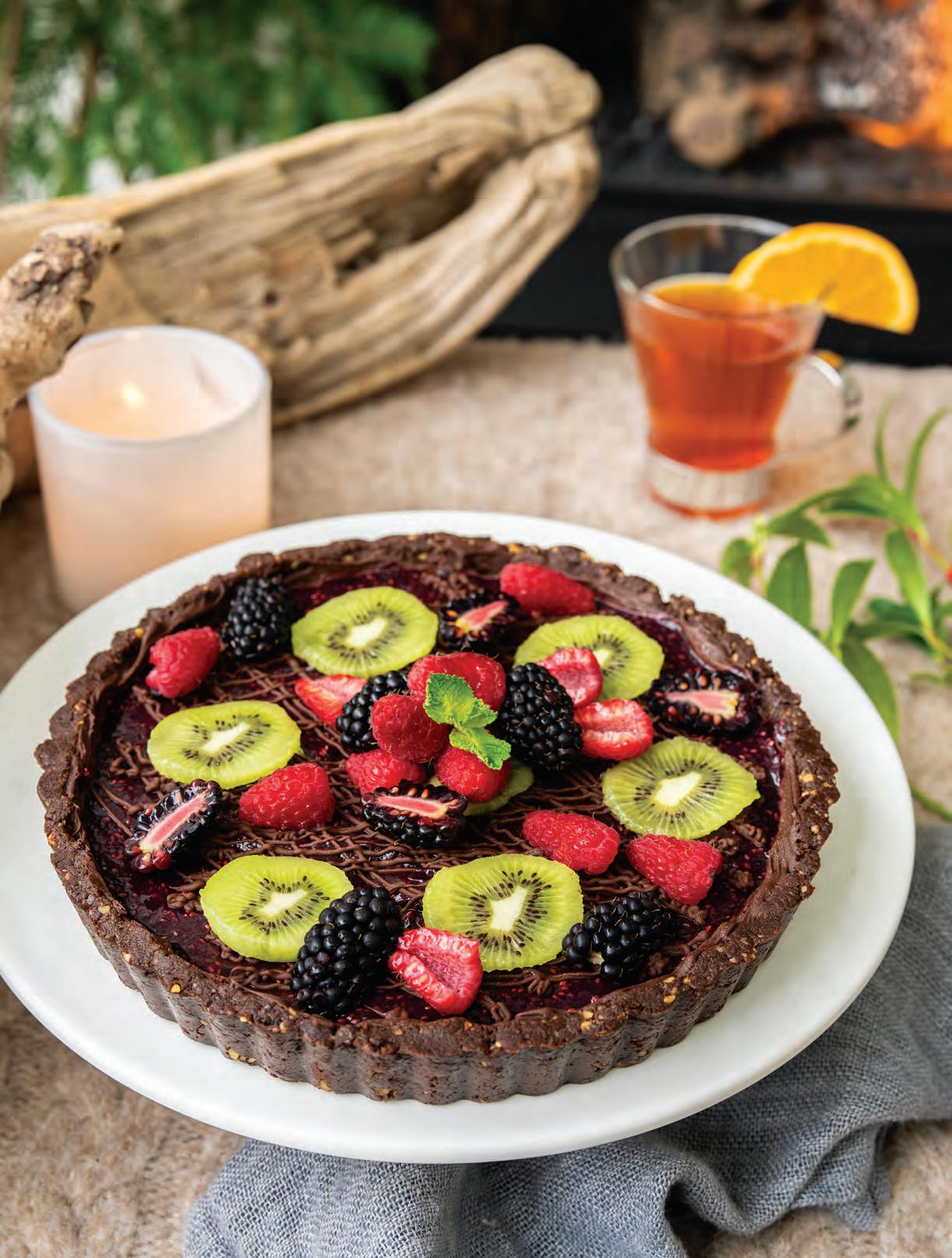
This remarkable tart lends itself well to a bevy of flavours. We conjoined raspberries with chocolate and orange in our tart. But you can stretch the boundaries with all sorts of fruits such as mango, pineapple, and papaya. If you’re longing to go somewhere tropical but the opportunity has scooted away, make this timely tart and fill it with the flavours of the tropics.

WHILE PUTTING A HANDFUL of veg-centric recipes into rotation at this time of year can move the healthy eating needle in the right direction, bowls full of raw greens can hold little appeal when you’re living in the deep freeze of winter. The days when cold salads are what you crave might still be a while away.
But you can fill your bowls with more seasonally appropriate foods that can not only give your body the nutrition it needs but also make you feel so much cozier. When composed smartly, a single bowl of warm food packs a serious punch of nutrition and good taste—a perfect antidote to a cold winter’s day.
Kick-start the year with these hearty, healthy, one-bowl wonders—a little warmth, a lot of nourishment, and none of the heaviness.
This is basically a warm hug in a bowl—a simple stew that celebrates the flavours of the season. With nourishing ingredients and minimal effort in the kitchen, this meal tastes best with a big hunk of sourdough for dunking and good company to share it with. If desired, you can swap out the turkey sausage for a plant-based version and the sage for fresh rosemary.
SERVES 4
2 tsp (10 mL) grapeseed oil or avocado oil
1 lb (450 g) turkey sausage, roughly chopped
1 onion, chopped
2 medium parsnips, chopped
1/2 tsp (2 mL) salt
1 Tbsp (15 mL) grainy Dijon-style mustard
1/4 cup (60 mL) fresh sage, chopped
2 Tbsp (30 mL) fresh thyme
1/4 tsp (1 mL) black pepper
3 cups (750 mL) butternut squash, peeled and cubed
1 1/2 cups (350 mL) hard apple cider
3 cups (750 mL) low-sodium vegetable broth
1 - 19 oz (540 mL) can navy beans, drained and rinsed
1 large Granny Smith apple, cubed
STEPS
1. In large saucepan, heat oil over medium heat. Add sausage and cook until browned. Remove sausage from pan and set aside.
2. Place onion, parsnips, and salt in pan; heat for 6 minutes, stirring occasionally, until onion is softened. Add mustard, sage, thyme, and black pepper to pan and heat for 1 minute. Place squash and cider in saucepan and simmer for 2 minutes. Pour in broth and gently simmer for 15 minutes. Add beans and apple; simmer for 10 minutes before ladling out into 4 separate bowls for serving.
When making stews, it’s best to gently simmer the contents instead of letting them go at a roaring boil. If you want to concentrate the flavours of the dish, you want a slow simmer.
“WITH NOURISHING INGREDIENTS AND MINIMAL EFFORT IN THE KITCHEN, THIS MEAL TASTES BEST WITH A BIG HUNK OF SOURDOUGH FOR DUNKING AND GOOD COMPANY TO SHARE IT WITH.”
Tahini adds richness to the broth of this satisfying plant-based stew that’s perfect for any nippy night. If possible, prepare this stew a day or two in advance of serving, as the flavours only get better with time. Each bowl is also a rich source of fibre to help bolster digestive health. Look for za’atar and harissa at Middle Eastern grocers.
SERVES 4
1 Tbsp (15 mL) extra-virgin olive oil
1 1/2 cups (350 mL) finely chopped onion
1/2 cup (125 mL) finely chopped celery
2 garlic cloves, peeled and finely chopped
1 tsp (5 mL) cumin seeds
2 tsp (10 mL) harissa paste
2 tsp (10 mL) za’atar, or 1 tsp (5 mL) dried thyme
1/2 tsp (2 mL) salt
4 cups (1 L) low-sodium vegetable broth
2 - 14 oz (398 mL) cans chickpeas, drained and rinsed
2 cups (500 mL) peeled and finely diced sweet potato
3 Tbsp (45 mL) tahini paste
1 cup (250 mL) roasted red peppers
1/3 cup (80 mL) chopped toasted walnuts
STEPS
1. In large pot, heat oil over medium-high heat. Add onion and celery and cook for 6 minutes. Stir in garlic and cumin seeds; heat for 1 minute. Stir in harissa, za’atar, and salt; heat for 1 minute. Add broth to the pot along with chickpeas, sweet potato, and tahini. Bring to a boil, then cover and simmer over low heat for 25 minutes.
2. Ladle stew into serving bowls and garnish with roasted peppers and walnuts.
“TAHINI
ADDS RICHNESS TO THE BROTH OF THIS SATISFYING PLANT-BASED STEW THAT IS PERFECT FOR ANY NIPPY NIGHT.”
Harissa paste is a spicy condiment that is a staple of North African and Middle Eastern cuisine. It’s made from a blend of chili peppers, garlic, olive oil, and a bunch of aromatic spices including cumin, coriander, and caraway. This vibrant red paste adds a fiery, tangy kick to dishes. But, once stirred into soups and stews, its fieriness is tamed.

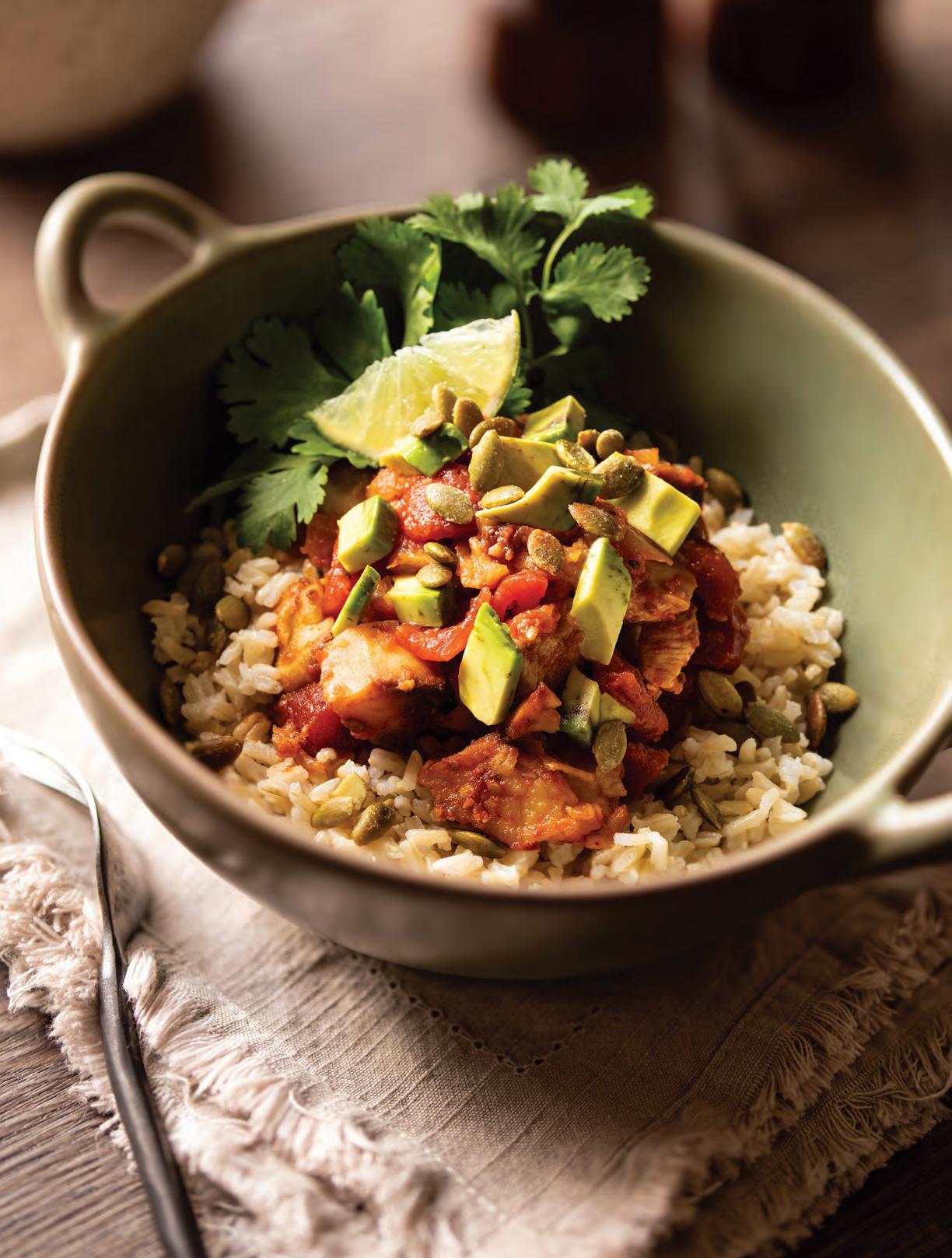
Consider this a hefty one-bowl meal with minimum fuss and maximum taste: proof that straightforward and simple can also be delicious and satisfying. You can also add dollops of sour cream. If you want fewer carbs, it’s possible to omit the rice.
2 large sweet potatoes, peeled and cut into 1 in (2.5 cm) cubes
4 tsp (20 mL) grapeseed oil or avocado oil, divided
1/2 tsp (2 mL) salt, divided
3 garlic cloves, peeled and chopped
1 small red onion, finely diced
1 lb (450 g) skinless, boneless chicken breast, cut into 1 in (2.5 cm) chunks
1 large or 2 small chipotle chili peppers in adobo sauce, chopped
2 tsp (10 mL) dried oregano
19 oz (540 mL) can diced tomatoes
2 cups (500 mL) cooked brown rice
1 avocado, sliced 1/4 cup (60 mL) pumpkin seeds
1/2 cup (125 mL) cilantro
1 lime
STEPS
1. Preheat oven to 400 F (200 C).
2. Toss sweet potato cubes with 2 tsp (10 mL) oil and 1/4 tsp (1 mL) salt. Spread out on rimmed baking sheet and bake until tender, about 40 minutes.
3. In large skillet, heat 2 tsp (10 mL) oil. Add garlic and red onion; heat for 5 minutes. Add chicken pieces and cook for 3 minutes. Stir in chipotle chili pepper, oregano, and 1/4 tsp (1 mL) salt. Pour tomatoes into skillet, bring to a simmer, and cook for 15 minutes. Stir in baked sweet potato cubes and heat for 5 minutes.
4. Divide cooked rice among 4 serving bowls and top with chicken-potato mixture, avocado, pumpkin seeds, and cilantro. Squeeze on lime juice.
Consider canned chipotle peppers your answer for infusing meals with a wallop of smoky heat. These are smoked and dried jalapenos that are rehydrated and canned along with adobo sauce, a purée of tomato, vinegar, garlic, and other spices. Opened cans will keep in the fridge for several weeks.
“CONSIDER THIS A HEFTY ONE-BOWL MEAL WITH MINIMUM FUSS AND MAXIMUM TASTE: PROOF THAT STRAIGHTFORWARD AND SIMPLE CAN ALSO BE DELICIOUS AND SATISFYING.”
During the blustery winter months, it’s always nice to serve salads with a warming element. Here, oven-roasted plant-based meatballs, tender farro, and oh-so-sweet sautéed tomatoes give this meal in a bowl star power. It’s a family meal that’s healthy, colourful, and satisfying. Instead of farro, you can use your favourite cooked grain, such as quinoa. Or leave the whole grains out altogether and serve with toasted pita bread. It’s also possible to make meatballs with ground beef, pork, or chicken.
SERVES 4
1 cup (250 mL) farro
1 lb (450 g) plantbased ground “meat” 2 tsp (10 mL) Italian seasoning
1 tsp (5 mL) cumin powder
1/2 tsp (2 mL) black pepper
2 Tbsp + 2 tsp (30 mL + 10 mL) extra-virgin olive oil, divided
2 cups (500 mL) halved cherry or grape tomatoes
2 garlic cloves, peeled and chopped, divided
1/2 cup (125 mL) hummus
1 tsp (15 mL) smoked paprika
1 Tbsp (15 mL) fresh lemon juice
8 cups (2 L) baby spinach
STEPS
1. In saucepan, place farro, 3 cups (750 mL) water, and a couple of pinches of salt. Bring to a boil, reduce heat to medium-low, and simmer, covered, until grains are tender, about 15 minutes. Drain any excess water.
2. Preheat oven to 375 F (190 C).
3. In large bowl, gently mix together ground “meat,” Italian seasoning, cumin, and black pepper. Form into golf ball-sized meatballs and place on rimmed baking sheet lined with parchment paper. Bake in preheated oven for 25 minutes.
2 cups (500 mL) sliced cucumber
1/2 cup (125 mL) crumbled feta cheese
1/4 cup (60 mL) sliced kalamata olives
1/2 cup (125 mL) parsley
assembly required
A big bowl of nutrition needn’t take an equally big commitment of your time. Here are some tips for putting together one-bowl meals in a flash when hunger strikes.
Cook up big batches of grains such as quinoa and brown rice in advance to use as bases for bowl meals. When cooked, they’ll keep in the fridge for up to five days or for up to three months in the freezer.
For vegetables that are best served cooked, consider dealing with these in advance. This can include steaming florets of broccoli, roasting cubes of sweet potato, and baking several beets. These cooked veggies will keep in your fridge for several days.
Be sure to have any vegetables you’ll serve raw, including lettuce greens and cherry tomatoes, on hand for when you need them. Items such as carrots and radishes can be sliced a few days ahead of time.
4. In skillet over medium heat, add 2 tsp (10 mL) olive oil. Add tomatoes and half the garlic and heat until tomatoes have softened and are beginning to break down, about 7 minutes.
5. In small bowl, whisk together hummus, 2 Tbsp (30 mL) olive oil, remaining garlic, paprika, and lemon juice.
6. Divide spinach among 4 serving bowls and top with farro, cucumber, tomatoes, and meatballs. Scatter on feta, olives, and parsley. Drizzle on hummus dressing.
To press the easy button, you can turn to proteins that don’t require any legwork in the kitchen. These include canned beans, smoked tofu, canned fish, and rotisserie chicken.
Decide what dressings and sauces you want for finishing off a bowl meal and whisk these up beforehand. Many of these can be heated before serving if you prefer a more warming dish.
Determine what flavour boosters and toppings you want to use and determine what can be done ahead of time so they’ll be ready to go when it’s mealtime. For instance, pre-toast nuts, grate a bunch of cheese, or pickle some sliced onions.

“OVEN-ROASTED PLANT-BASED MEATBALLS, TENDER FARRO, AND OH-SO-SWEET SAUTÉED TOMATOES GIVE THIS MEAL IN A BOWL STAR POWER.”

There’s no need to shy away from white foods. Not only are many white foods nutritional powerhouses, full of the nutrients our bodies need, but they are widely available. They seem to be the same foods that store well and are easily accessible.
In wintertime when fresh produce can be less available, winter vegetables such as parsnips and mushrooms are welcome friends, adding delicious texture and tastes to our soups and stews along with vitamins C and D.
White beans, including navy and cannellini beans, are full of folate. Dried or canned, they’re easy to cook with. Their versatility aids their use in many different dishes, and their high fibre content can help us feel satisfied.
White foods are also delicious and varied. Omega-3-rich white fish, protein-packed cheeses such as ricotta and mozzarella, nuts and nut milks, sesame seeds, and vegetables such as radish, cauliflower, and potatoes all have something different to offer in terms of nutrition, flavour, and texture, as well as a variety of ways to enjoy them.

The nutritional and health benefits associated with plant-based white foods are numerous. Here are just some of what’s available and where to find them.
NUTRITIONAL COMPONENT
PROTEIN
OMEGA-3S
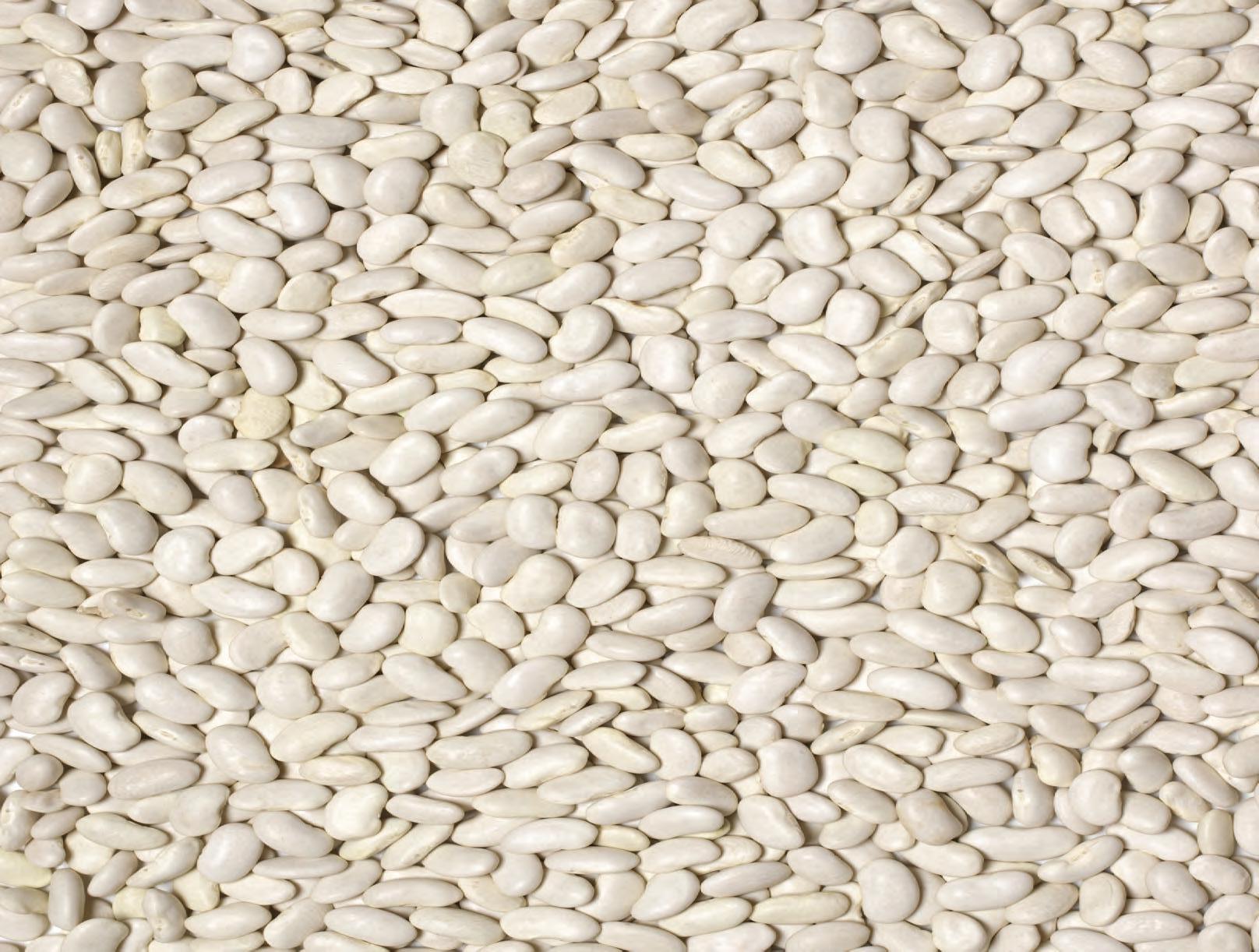
VITAMIN C
POTASSIUM
FOLATE
FIBRE
PHYTONUTRIENTS
BENEFITS
helps build muscle, strengthen bones, support immune system function
source of energy essential for key body functions; help lower inflammation and regulate triglycerides; help fight heart disease
helps strengthen immune system, protect against heart disease, and vital for eye health; as an antioxidant, guards against cell damage from free radicals
moves nutrients into our cells, helps kidneys and muscles function properly and nerves work
helps cells function; key to formation of RNA and DNA; increased levels may reduce risk of cancer and cardiovascular disease
key to digestive health; plays a role in weight loss
quercetin (a flavonol) may reduce risk of cancer and heart disease; lignans (a carotenoid) may prevent osteoporosis and endometrial cancer
tofu, almonds, cashews, beans
fish, nuts and seeds such as hemp hearts, plant oils such as flaxseed oil
cauliflower, parsnips, potatoes
potatoes, navy beans, parsnips, bananas, coconuts
white beans, bananas, and cauliflower; added to processed foods such as white flour
potatoes, beans, parsnips, oats, bananas, nuts, popcorn
onions, pears, apples (quercetin); sesame seeds, flaxseeds (lignans)
These scrumptious and versatile tartines make an excellent snack, lunch, or breakfast. Protein- and calcium-rich, creamy ricotta is first whipped up with honey and flavoured with parsley and red pepper flakes. Then it’s slathered on slices of sourdough baguette and topped with sautéed mushrooms and leeks. All that deliciousness comes with fewer calories and lower levels of salt and fat than many other cheeses.
6
1 cup (250 mL) ricotta
1 Tbsp + 1 tsp (15 mL + 5 mL) honey, divided
1 Tbsp (15 mL) chopped parsley
Zest of one lemon
1 Tbsp (15 mL) fresh lemon juice
1/4 tsp (1 mL) dried red pepper flakes (optional)
2 Tbsp (30 mL) extra-virgin olive oil, divided
4 oz (113 g) white button mushrooms, cleaned and quartered
1 tsp (5 mL) low-sodium soy sauce
1 small leek, about 4 oz (113 g), cut into 1/4 inch (0.6 cm) round slices
6 slices of sourdough baguette
“THESE SCRUMPTIOUS AND VERSATILE TARTINES MAKE AN EXCELLENT SNACK, LUNCH, OR BREAKFAST.”
1. In small bowl, combine ricotta, 1 Tbsp (15 mL) honey, parsley, lemon zest and juice, and red pepper flakes (if using). Whip ricotta by hand using whisk or with electric mixer for about 2 minutes, until ricotta is light and creamy. Set aside.
2. In skillet, heat 1 Tbsp (15 mL) olive oil on medium-high heat. Add mushrooms and cook until brown on all sides, stirring only very occasionally. Add soy sauce to deglaze pan; tip mushrooms onto plate and set aside.
3. In the same skillet, heat remaining 1 Tbsp (15 mL) olive oil on medium heat. Add leek slices and cook carefully for 1 to 2 minutes each side, turning with palette knife or cake spatula, until tender and browned. Remove from heat.
4. Spread ricotta onto baguette slices and top with mushrooms and 2 or 3 leek slices. Drizzle tartines with remaining 1 tsp (5 mL) honey and serve.
You can refrigerate the individual components of this dish (flavoured ricotta, cooked mushrooms, cooked leeks) until you’re ready to assemble or to save for the next day. Serve cold or reheat mushrooms by adding a little water or chicken stock while you heat gently in a skillet. Do the same with the leeks.
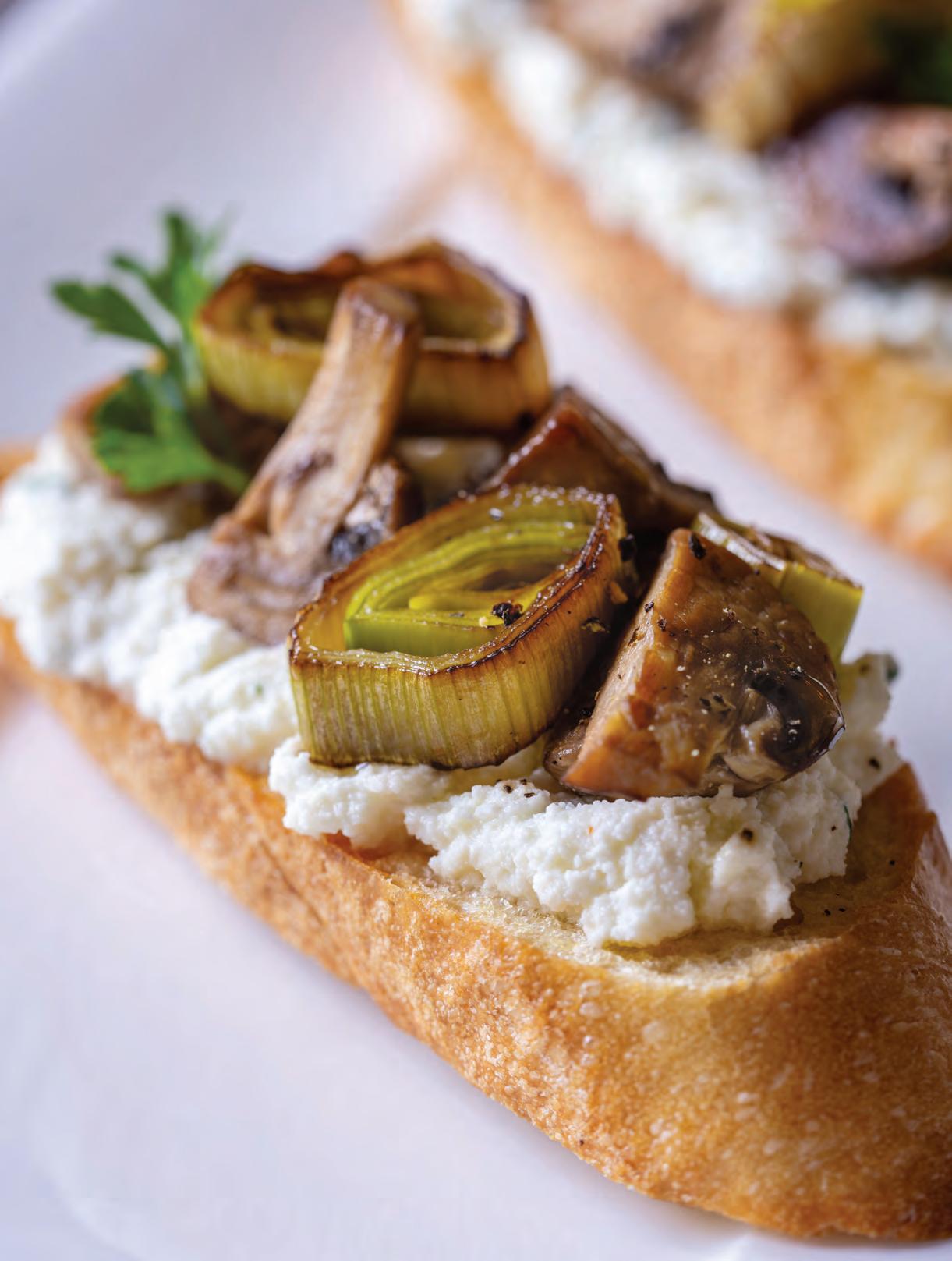


A creamy lemon dressing with bright mint and sharp hits of feta lends a zesty bite to Brussels sprouts and almonds in this fresh, crunchy salad. Sure to satisfy, this protein- and fibre-rich salad goes a long way and keeps hunger at bay. Feta is relatively low in fat compared to other cheeses and high in protein, calcium, and phosphorus. Eating these nutrients together has been linked to improved bone density.
1 lb (450 g) Brussels sprouts
5 to 6 red radishes, sliced thinly
2 tsp (10 mL) lemon zest
3 Tbsp (45 mL) lemon juice
3 Tbsp (45 mL) Greek yogurt
1 1/2 tsp (7 mL) honey
2 tsp (10 mL) chopped mint
Salt and pepper, to tase (optional)
3 oz (85 g) crumbled feta (about 1/2 cup/125 mL)
1/2 cup (125 mL) slivered almonds
1. Wash and remove rough outer leaves from Brussels sprouts and trim stem. Shave Brussels sprouts using mandoline or slicer attachment of food processor. Add to large bowl along with sliced red radishes and set aside.
2. In 2 cup (500 mL) Mason jar, add lemon zest, lemon juice, yogurt, honey, and mint; shake well to combine. Pour dressing over shaved Brussels sprouts, mixing well. Add about three-quarters of feta and almonds; mix through to incorporate evenly. Transfer mixture to serving bowl or plate and sprinkle remaining feta and almonds overtop.
If raw Brussels sprouts aren’t your cup of tea, you could make this salad just as tasty by roasting the shaved sprouts on a baking sheet, drizzled with 1 Tbsp (15 mL) extra-virgin olive oil in a 400 F (200 C) oven for about 20 minutes. Allow sprouts to cool slightly and then toss with dressing, feta, and almonds as instructed above.
“A CREAMY LEMON DRESSING WITH BRIGHT MINT AND SHARP HITS OF FETA LENDS A ZESTY BITE TO BRUSSELS SPROUTS AND ALMONDS IN THIS FRESH, CRUNCHY SALAD.”
Grated white parsnips, formed into rosti and baked, make for a perfect crispy bed to lay down some wilted greens and sweet, juicy, omega-3-rich scallops. A dash of nutmeg in both the rosti and wilted greens pairs beautifully with the sweet flavour of the scallops and parsnips, while vinegar lends a hint of acid for balance.
SERVES 6
18 scallops
1 1/2 Tbsp (22 mL) extra-virgin olive oil, divided
1 large parsnip, about 8 oz (225 g)
1/2 tsp (2 mL) salt, divided 3/4 tsp (4 mL) pepper, divided 1/2 tsp (2 mL) nutmeg, divided
1 Tbsp (15 mL) cornstarch
2 Tbsp (30 mL) chopped parsley
1 organic egg
2 Tbsp (30 mL) grapeseed oil
5 oz (140 g) baby spinach or arugula, or a mixture of both
2 Tbsp (30 mL) sherry or red wine vinegar
STEPS
1. Remove scallops from refrigerator and allow to come to room temperature before cooking, (about 1/2 hour before serving time).
2. Preheat oven to 425 F (220 C). Prepare baking sheet by greasing it with 1 Tbsp (15 mL) olive oil and set aside.
3. Peel and trim parsnip and grate using box grater or food processor with grater attachment. In large bowl, combine grated parsnip with 1/4 tsp (1 mL) salt, 1/2 tsp (2 mL) pepper, 1/4 tsp (1 mL) nutmeg, and cornstarch. Add parsley and stir to combine. Make a well in base of bowl and add egg. With fork, beat egg, and mix into parsnips. Add 1/2 Tbsp (7 mL) olive oil and stir through.
4. Form parsnip mixture into 6 patties, and place on prepared baking sheet (see tip box). Using metal spatula, press patties down to flatten them. Bake in preheated oven for 8 minutes. Remove from oven and, using spatula, carefully turn over. Return to oven and bake for an additional 6 minutes on the second side.
5. In large skillet, heat grapeseed oil on medium-high heat. Pat scallops dry, season with 1/4 tsp (1 mL) salt, and place on hot pan. Cook on each side until brown and turn (about 2 minutes each side). Remove to plate and keep warm. In same skillet, add greens and cook for a few minutes, stirring, until wilted. Add vinegar and season with 1/4 tsp (1 mL) pepper and 1/4 tsp (1 mL) nutmeg.
6. To serve, lay out 6 plates and place a warm parsnip rosti on each plate. Top each rosti with some wilted greens and then arrange 3 scallops on top of each.
“GRATED WHITE PARSNIPS, FORMED INTO ROSTI AND BAKED, MAKE FOR A PERFECT CRISPY BED TO LAY DOWN SOME WILTED GREENS AND SWEET, JUICY, OMEGA-3-RICH SCALLOPS.”

When forming the rostis, use a ring cutter to make perfect circles and a condiment bottle to tamp them down. Use ring mold again when topping the rostis.
To make ahead, bake rostis as instructed and allow to cool completely. Store in an airtight container in the refrigerator until just before ready to serve. To reheat, warm on a silicone- or parchment-lined baking sheet at 300 F (150 C) for about 10 minutes.

The versatility of white beans shines through in this dish, which employs them in two different ways: simmered and then roasted until crispy. The beans crown luscious sweet potato, flavoured with sage and thyme, heaped high on crispy tortillas. Not only do the beans provide a good source of protein, but the fibre in this dish provides 57 percent of our recommended daily value, along with healthy amounts of iron and potassium.
SERVES 4
2 large sweet potatoes, about 2 lbs (1 kg) total
1 Tbsp + 8 tsp (15 mL + 40 mL) extra-virgin olive oil, divided
3/4 tsp (4 mL) salt, divided 1/2 tsp (2 mL) pepper, divided
1 Tbsp (15 mL) fresh thyme leaves + 1 thyme sprig
2 tsp (10 mL) chopped fresh sage + 2 whole leaves
14 oz (398 ml) can no-added-salt cannellini beans
1 bay leaf
1/2 tsp (2 mL) smoked spicy Spanish paprika
1/4 tsp (1 mL) garlic powder
8 corn tortillas
1. Preheat oven to 400 F (200 C).
2. Wash and trim sweet potatoes, leaving peel on. Cut each down the middle lengthwise and rub all over with 1 Tbsp (15 mL) olive oil. Place on baking sheet, cut side up, and sprinkle with 1/4 tsp (1 mL) salt, 1/4 tsp (1 mL) pepper, thyme leaves, and chopped sage. Bake in preheated oven for 50 minutes, turning them to face down halfway through cooking time.
3. Meanwhile, drain and rinse beans and set 1/2 cup (125 mL) aside to dry in single layer on kitchen towel-lined plate. In small saucepan, place remaining beans with bay leaf, thyme sprig, and sage leaves and add enough cold water to just cover. Heat on medium-low for about 10 to 15 minutes, until warmed through. Time the start so they are ready just as sweet potatoes are finishing in the oven, and keep warm in the hot water, adding 1/4 tsp (1 ml) salt. Pat reserved beans with kitchen towel and season with spicy paprika and garlic powder.
4. Remove sweet potatoes from oven, remove their skins, and place flesh in large bowl. Toss reserved beans on the same baking sheet, coating them in the remaining oil and herbs. Return baking sheet to oven and bake beans for 15 minutes, until crispy, stirring occasionally.
5. Brush each tortilla on both sides with 1 tsp (5 mL) olive oil and bake on baking sheets for 5 minutes, or until brown, turning halfway through.
6. While tortillas are warming, with fork, mash sweet potatoes and cover to keep warm. Drain simmering beans.
7. To assemble tostadas, divide mashed sweet potato among tortillas, add a few simmered beans, and top with spicy crispy beans. Season with 1/4 tsp (1 mL) salt and 1/4 tsp (1 mL) pepper.
Rinsing beans before you use them will help remove any salt. Even if you are using no-salt-added beans, rinsing the beans will prepare them for you to infuse your own flavours into them.
“THE VERSATILITY OF WHITE BEANS SHINES THROUGH IN THIS DISH, WHICH EMPLOYS THEM IN TWO DIFFERENT WAYS: SIMMERED AND THEN ROASTED UNTIL CRISPY.”

Vitamin B2 from Webber Naturals provides 100 mg of riboflavin per daily dose. It’s a convenient, vegan-friendly way to support energy metabolism, red blood cell creation, and the circulation of iron in the body. Vitamin B2 is necessary for the conversion of vitamin B6 and folate into their active, usable forms.
WEBBERNATURALS.COM | 1-800-430-7898

tentree
Melatonin Gummies 2.5 mg from Webber Naturals are a non-habit-forming sleep aid that restore the natural sleep-wake cycle for better, more restorative sleep. When sleep patterns are disrupted, these delicious strawberry-flavoured gummies make it easier to improve sleep quality so you can wake up refreshed.
WEBBERNATURALS.COM | 1-800-430-7898
Made for your everyday adventure, tentree essentials are just as easy on the planet as they are to wear. From throw-on-and-go dresses (like this one) to super soft shorts and tees, everything is made with responsibly sourced materials. Plus, every piece plants trees.
TENTREE.COM




Michelle von Hahn alive Academy Graduate, Recipe Developer, Blogger, Health Enthusiast @healthynumnumblog
Join thousands of alive Academy graduates on the frontlines of the health and


Here’s a handy roundup of de-stressing and overall wellness supports from this issue of sage. Read through this list and make a note of the ones that make sense for you and your family. Then breeze through the grocery store, confident that you’re filling your cart with seriously healthy star power.

Greens powders (P.18) support overall wellness when veggie intake is low.

Iron (P.26) helps prevent anemia, promote sleep quality, and strengthen the immune system.

Tamarind (P.10) has shown promise for its positive effect on dry eye, peptic ulcers, and inflammation.

Magnesium (P.23) may help improve sense of anxiety and help treat depression.
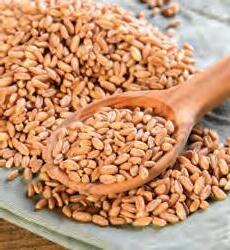
Farro (P.48) is an excellent source of fiber, magnesium, and iron.

Rhodiola (P.23) influences the release of stress hormones and may improve stress-induced conditions.

Probiotics (P.23) may improve mental function among those with anxiety and depression.


WE’RE CHALLENGING YOU TO SET A SIMPLE BUT LIFE-CHANGING GOAL. YOU’VE GOT THIS!
Several studies have found that keeping a consistent sleep schedule can improve your overall health. Zzz!
We all know how important sleep is for our bodies, and recent studies are showing that the more consistent your sleep schedule is, the more benefits you reap. One 2020 systematic review published in Applied Physiology, Nutrition, and Metabolism found that sleep variability is associated with negative health outcomes, and its authors encouraged consistent bedtimes and wake-up times for their positive health benefits.
A 2023 study also found that sleep regularity can be a predictor of mortality risk, with a higher irregularity in sleep being associated with a higher chance of mortality, cancer risk, and cardiometabolic issues. This makes the reverse also true: the more consistent your sleep schedule, the lower the risk of these health issues. A consistent sleep schedule can also help reduce stress, increase alertness, and improve heart health.

Ready to regulate your sleep schedule? Here are some tips: Set bedtime reminders and consistent morning alarms.
Stick to a nighttime routine, such as meditating, skincare, or reading before bed.
Limit weekend sleep-ins to one to two extra hours a morning.
TIP: There’s an app for that! Your phone and smart watch can be great tools to help you track your sleep, set alarms, and listen to soothing bedtime songs or stories. Just make sure to limit your screen time before bed so that your device’s blue light doesn’t negatively affect your sleep.



























Triple-action, tri-layer tablets for immediate and gradual release
• With and calming
5-HTP and calming L-theanine
• Contains sleep botanicals: valerian, passionflower, and hops























• Promotes falling asleep quickly and improves sleep quality local pharmacy or grocery store!
























































































